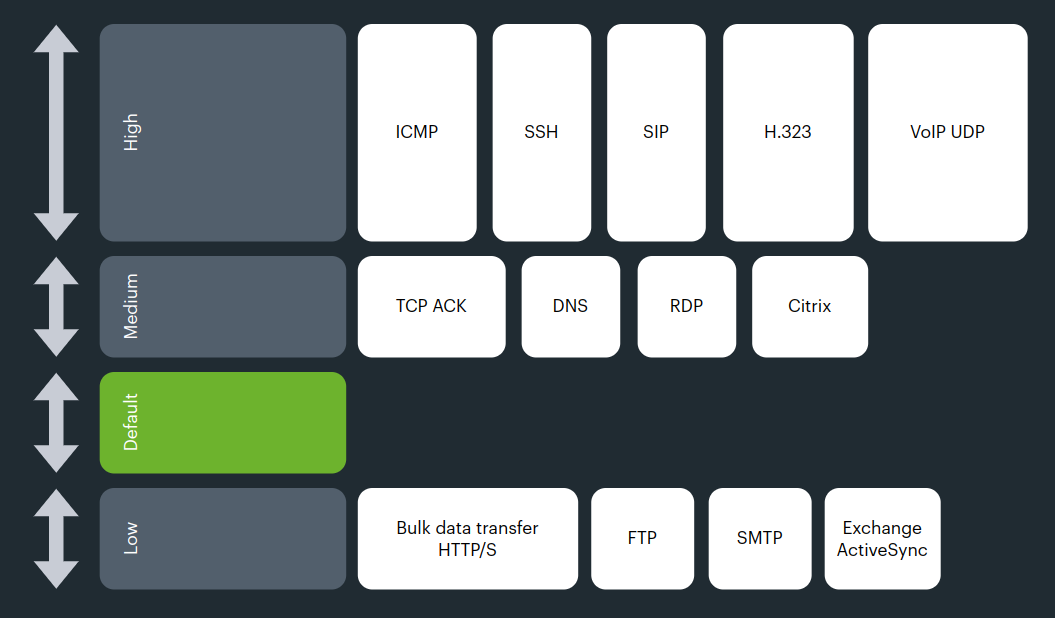QoS
Packet classification and queueing#
Our aggregation technology takes apart data streams at the packet level for onward transit over a Tunnel Aggregation Group (TAG).
Before this process takes place on an EVX or NFR, packets are classified within the Multipath packet vector engine.
This classification process involves comparing attributes on each packet with a pre-configured set of application templates before sending each packet into the QoS engine itself.
Entire application data streams are then prioritised bi-directionally and put into traffic classes.
These traffic classes then have a set of rules apply to them so that any data stream can have full access to the aggregation bandwidth of the connection unless and until a higher priority datastream is started.
Higher priority packets get sent first, and lower priority packets are queued.
QoS profiles#
A standard set of QoS profiles exist for the usual use cases for businesses of all sizes. These can be customised for individual connections or entire customer networks.
The starting point is always a standard profile, involving the default prioritisation of time sensitive traffic such as interactive traffic like RDP, VoIP etc.
Important packets such as TCP acknowledgements and DNS requests are prioritised highly in order to avoid retransmissions and smooth data transfers, and to ensure web pages load quickly.
Bespoke profiles can be created from templated starting points in order to specifically target the applcation infrastructure the customer network is using.
Bi-directional#
Packets are queued and prioritised between the edge EVX appliances and the backbone Network Fabric Routers (NFRs) before being sent to their final destination.
If this destination is on the internet or to another third party network, then the rest of the packet's journey cannot be guaranteed.
If the destination is on the SD-WAN, then it will continue its classification and prioritisation to an edge EVX or NFR before delivery, maintaining its state.
This prioritisation happens for both upload and download traffic, and is not limited to just a single direction.
Zero touch & existing packet tags#
Packets need not be tagged before reaching the EVX or NFR. Customers are recommended in most circumstances to remove all QoS related rules and services on their edge routers and firewalls, unless a complex configuration is agreed with Evolving Networks engineering teams.
Existing tags can be honoured, and this is often useful for situations where packets are encrypted inside a VPN. VoIP packets, for example, could be tagged with a standard DSCP marker, so that the voice calls within a VPN get priority over the bulk data transfers over the same VPN.
Without that existing classification, the only prioritisation possible is for the entire VPN, not individual applications within it.
Layer 2 - 4#
The following packet filters are available in any combination, along with existing tags.
- Packet size
- Flow length
- Source IP
- TOS
- VRF
- Source port
- Protocol
- Destination IP
- Connection tracking
- COS
- Destination port
- DSCP
- TCP flags
- Flow direction
- Connection frequency
- VLAN
- DSCP EF
- ICMP type
- Physical port
- MAC address
New profiles and templates can be created, to add to the existing bank of filters for known applications.
Customisable overhead#
Part of the way that packets are classified into classes involves an overhead margin of a small percentage of bandwidth.
This protects the connection during saturation depending on the variability of the bandwidth.
The more variable the bandwidth the higher the margin needs to be.
This is customisable on every connection depending on if it is comprised of reliable fixed link ethernet, or unstable 4G/5G.
Queuing disciplines#
The following queuing disciplines are used in our standard templates.
